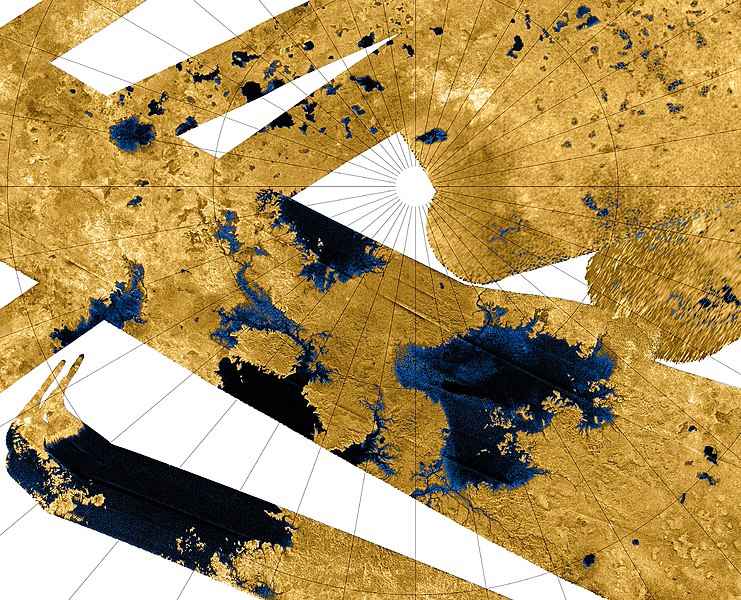File:PIA10008 Seas and Lakes on Titan.jpg

Original file (2,348 × 1,900 pixels, file size: 2.62 MB, MIME type: image/jpeg)
| This is a file from the Wikimedia Commons. The description on its description page there is shown below.
|
Summary
| DescriptionPIA10008 Seas and Lakes on Titan.jpg |
This Cassini false-color mosaic shows all synthetic-aperture radar images to date of Titan's north polar region. Approximately 60 percent of Titan's north polar region, above 60 degrees north latitude, is now mapped with radar. About 14 percent of the mapped region is covered by what is interpreted as liquid hydrocarbon lakes. Features thought to be liquid are shown in blue and black, and the areas likely to be solid surface are tinted brown. The terrain in the upper left of this mosaic is imaged at lower resolution than the remainder of the image Most of the many lakes and seas seen so far are contained in this image, including the largest known body of liquid on Titan. These seas are most likely filled with liquid ethane, methane and dissolved nitrogen. Many bays, islands and presumed tributary networks are associated with the seas. The large feature in the upper right center of this image is at least 100,000 square kilometers (40,000 square miles) in area, greater in extent than Lake Superior (82,000 square kilometers or 32,000 square miles), one of Earth's largest lakes. This Titan feature covers a greater fraction of the surface, at least 0.12 percent, than the Black Sea, Earth's largest terrestrial inland sea, at 0.085 percent. Larger seas may exist, as it is probable that some of these bodies are connected, either in areas unmapped by radar or under the surface (see PIA08365). Of the 400 observed lakes and seas, 70 percent of their area is taken up by large "seas" greater than 26,000 square kilometers (10,000 square miles). The Cassini-Huygens mission is a cooperative project of NASA, the European Space Agency and the Italian Space Agency. The Jet Propulsion Laboratory, a division of the California Institute of Technology in Pasadena, manages the mission for NASA's Science Mission Directorate, Washington, D.C. The Cassini orbiter was designed, developed and assembled at JPL. The radar instrument was built by JPL and the Italian Space Agency, working with team members from the United States and several European countries. For more information about the Cassini-Huygens mission, visit http://saturn.jpl.nasa.gov/home/index.cfm. The original NASA image has been modified by rotating 90 degrees clockwise, cropping and reduction in size (the linear pixel density was reduced 50%). Some of the features in this image have been annotated in Wikimedia Commons. |
| Date | |
| Source | http://photojournal.jpl.nasa.gov/catalog/?IDNumber=PIA10008 |
| Author | NASA / JPL-Caltech / USGS |
| Other versions |
PIA10008 Seas and Lakes on Titan full size.jpg - larger, higher resolution version (4696 × 4696 pixels, 10.4 MB) |
This image or video was catalogued by Jet Propulsion Laboratory of the United States National Aeronautics and Space Administration (NASA) under Photo ID: PIA10008. This tag does not indicate the copyright status of the attached work. A normal copyright tag is still required. See Commons:Licensing. Other languages:
العربية ∙ беларуская (тарашкевіца) ∙ български ∙ català ∙ čeština ∙ dansk ∙ Deutsch ∙ English ∙ español ∙ فارسی ∙ français ∙ galego ∙ magyar ∙ հայերեն ∙ Bahasa Indonesia ∙ italiano ∙ 日本語 ∙ македонски ∙ മലയാളം ∙ Nederlands ∙ polski ∙ português ∙ русский ∙ sicilianu ∙ slovenščina ∙ Türkçe ∙ українська ∙ 简体中文 ∙ 繁體中文 ∙ +/− |
Licensing
| Public domainPublic domainfalsefalse |
| This file is in the public domain in the United States because it was solely created by NASA. NASA copyright policy states that "NASA material is not protected by copyright unless noted". (See Template:PD-USGov, NASA copyright policy page or JPL Image Use Policy.) |  | |
 |
Warnings:
|
| Annotations InfoField | This image is annotated: View the annotations at Commons |
Bolsena Lacus
Neagh Lacus
Sotonera Lacus
Jingpo Lacus
Punga Mare
Sparrow Lacus
Koitere Lacus
Kivu Lacus
Ligeia Mare
Kraken Mare
Mayda Insula
Uvs Lacus
Atitlan Lacus
Vanern Lacus
Sevan Lacus
Cayuga Lacus
Ohrid Lacus
Waikare Lacus
Logtak Lacus
Ladoga Lacus
Vid Flumina
north pole of Titan
Mayda Insula
Uvs Lacus
Atitlán Lacus
Sevan Lacus
Vänern Lacus
Ohrid Lacus
Logtak Lacus
Sparrow Lacus
Waikare Lacus
Cayuga Lacus
Mývatn Lacus
Captions
Items portrayed in this file
depicts
11 October 2007
image/jpeg
File history
Click on a date/time to view the file as it appeared at that time.
| Date/Time | Dimensions | User | Comment | |
|---|---|---|---|---|
| current | 20:01, 11 November 2013 | 2,348 × 1,900 (2.62 MB) | WolfmanSF | Slightly wider view on top and right |
File usage
The following page uses this file:
Metadata
This file contains additional information, probably added from the digital camera or scanner used to create or digitize it.
If the file has been modified from its original state, some details may not fully reflect the modified file.
| Image title |
|
|---|---|
| Width | 4,696 px |
| Height | 3,800 px |
| Bits per component |
|
| Compression scheme | LZW |
| Pixel composition | RGB |
| Orientation | Normal |
| Number of components | 3 |
| Horizontal resolution | 72 dpi |
| Vertical resolution | 72 dpi |
| Data arrangement | chunky format |
| Software used | Adobe Photoshop Elements 9.0 Windows |
| File change date and time | 18:47, 11 November 2013 |
| Color space | sRGB |
| Image width | 2,348 px |
| Image height | 1,900 px |
| Date and time of digitizing | 17:35, 11 November 2013 |
| Date metadata was last modified | 10:47, 11 November 2013 |
| Unique ID of original document | xmp.did:F91F80B83B4BE311912BDDC8D6A6D4C4 |
| IIM version | 39,607 |